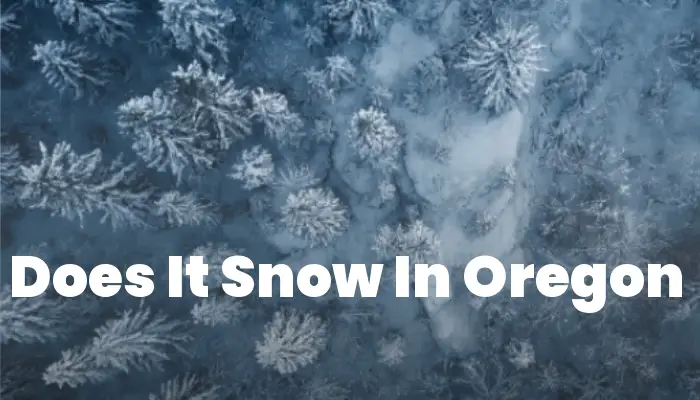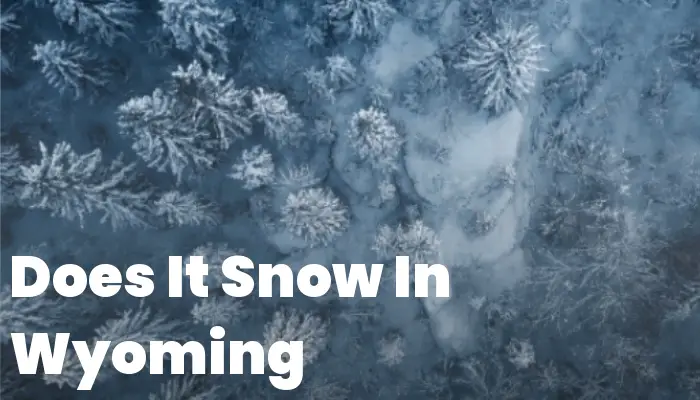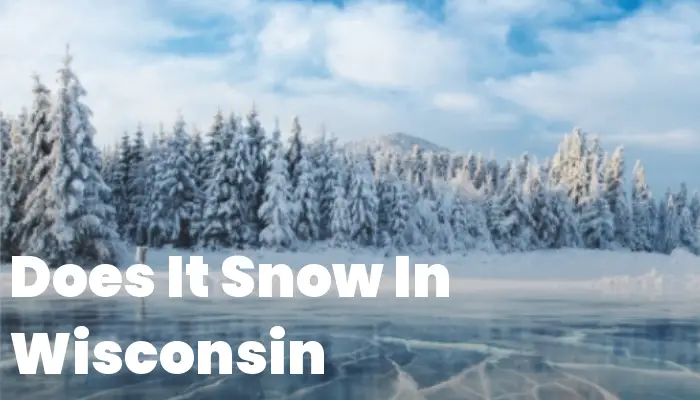Have you ever wondered, “Does it snow in Oregon?” Get ready to dive into an insightful exploration of Oregon’s winter climate.
From the Pacific coastline to the high desert areas, we’ll examine how much snow this diverse state experiences.
You may be surprised by what we uncover about Oregon’s weather patterns!
Does It Snow In Oregon?
Oregon, known for its lush landscapes and diverse geography, is no stranger to the phenomenon of snow. With climates ranging from coastal to alpine, many are curious: Does it snow in Oregon? The answer is a resounding yes. However, the frequency and intensity of snowfall can differ dramatically depending on where you are in the state.
The western part of Oregon, which includes cities like Portland and Eugene, experiences a more moderate climate thanks to the influence of the Pacific Ocean. Here, snowfall does occur but not as heavily or as frequently as in other parts of the state. As you move eastward towards the Cascade Range and further into Central Oregon’s high desert regions such as Bend and Klamath Falls, colder temperatures pave the way for more significant snow events.
Winter sports enthusiasts will be thrilled to know that mountain areas like Mount Hood and Mount Bachelor receive an ample amount of fluffy white powder suitable for skiing, snowboarding, and other winter activities. This highlights that while not all areas see heavy winter precipitation, certain regions offer a winter wonderland each year.
How Much Does It Snow In Oregon?
The question about how much it snows in Oregon intrigues both residents and visitors alike due to its varied climate zones. To put it simply – it varies greatly.
In coastal cities like Astoria or Newport, you might see an occasional dusting with only 1-3 inches annually on average. Contrastingly, Bend receives around 24 inches per year. Yet even this pales in comparison to mountainous areas; for instance,
Mt. Hood’s Timberline Lodge amasses an astonishing average of over 500 inches every season.
Portland walks a middle line when it comes to snowfall with averages ranging from 1 to 8 inches per year—it’s a city where you could witness light urban flurries in one neighborhood while another might be covered by several inches during colder winters.
Those looking for precise measurements will find great variability within short distances due to Oregon’s complex topography. Therefore, if you’re planning on traveling through Oregon during winter months, checking local forecasts becomes essential for encountering unpredictable weather patterns linked closely with altitude changes.
Average Annual Snowfall by Region:
- Oregon Coast Range: less than 5 inches
- Willamette Valley: around 5-10 inches
- Southern Oregon (Medford): approximately 4-6 inches
- Cascade Mountains: over 300-500+ inches depending on elevation
- Eastertern/Central (Bend): roughly 20-30+ inches
Are There Ice Storms In Oregon?
The occurrence of ice storms is another facet of winter weather that draws attention when discussing temperatures below freezing point within various parts of Oregon.
Ice storms do hit Orgeon,, particularly impacting regions eastward from Willamette Valley up through Columbia River Gorge—a notorious spot for glacial gusts creating sheets upon sheets upon roads bridges.
These frigid spectacles unfold when rain droplets become supercooled directly contacting surfaces well under freezing temperature resulting coverage strategies transparent yet treacherous layers named after their ability impair traction pedestrian vehicle traffic alike Frozen precipitation hanging trees power lines add both magical ambiance increased risk physical damage disruption basic services electrical outages tree limb collapses common aftermath significant icing events
Moreover Willamette Valley occasionally witnesses these icy conditions although typically less severe than those experienced near Gorge Nevertheless they serve reminder residents visitors alike need stay prepared deal potential hazards come along living temporary visiting place possesses such dynamic weather personality
When comparing the weather patterns of various states, it’s interesting to note the differences and similarities. Oregon, for instance, does see snowfall, though it varies heavily throughout the state. Much like Pennsylvania, where snowfall is significant especially in mountainous regions.
However, if you compare this with Rhode Island, a coastal state, you’ll notice that while they do experience snow, their average yearly amount is less than both Oregon and Pennsylvania due to their maritime climate.
Moving down south to South Carolina, snow becomes even less frequent – a stark contrast from its northern counterparts. In fact, some years may pass without any substantial snowfall at all.
Finally, we have places like South Dakota, characterized by extreme weather swings, which can see heavy snow during winter months akin to Oregon’s higher altitude areas. Thus showcasing the diversity in climates and yearly snowfalls across US states.
Where Does It Snow In Oregon?
Oregon’s geography dictates where snowfall is more prevalent. The Cascade Mountains, acting as a climatic barrier, tend to receive the most snow, effectively separating the wetter western part of the state from the dryer east. Locations such as Crater Lake are known for their high annual snowfall, being among some of the snowiest places in Oregon.
The Columbia River Plateau, especially in its higher elevations, also sees significant amounts of snow. Cities like Pendleton and La Grande can experience moderate to heavy snowfall during winter storms. Meanwhile, lower elevation areas such as the Willamette Valley get relatively little accumulation but are not immune to an occasional blanket of white.
The coastal regions experience more rain than snow due to their proximity to the warm ocean currents; however, mountainous areas along the coast range, like Siskiyou Summit near Ashland, can receive notable levels of snowfall at times.
Average Annual Snowfall by City:
- Portland: around 1-8 inches
- Salem: about 6 inches on average
- Ashland (Siskiyou Summit): up to 60+ inches in elevated areas/li>
- Bend (Central Oregon): roughly 20-30+ inches/li>
/li>Eastern Oregon (Pendleton)</bf: closeproximity 30 inconeasty>
Oregon Roads and Winter Weather Conditions Couldon’
The Mt Hood Corridor and Santiam Pass are examples where drivers might face challenging conditions due to heavy snowfalls and potential blizzards. These mountain passes require chains or traction tires during severe weather.
Obeying posted signs for chain requirements is essential for safe travel. Oregon’s Department of Transportation actively updates road conditions through TripCheck.com, providing crucial information for those traveling in winter months.
On lower grounds like I-5 running through Salem or Eugene, winter driving is usually less problematic but may still be hazardous when cold spells hit and roads ice over rapidly. Oregon’s complex climate leads to a wide range in temperatures during wintertime. Temperatures vary dramatically depending not only on location but also elevation.
In coastal areas like Coos Bay or Tillamook temperatures typically stay above freezing even during nighttime| which reduces instances of persistent frost or deep freezes. On flip side Eastern Orgeon High Desert regions such as Baker City often endure frigid nights with mercury diving well below zero degrees Fahrenheit(-17°C)| highlighting stark contrast between different parts State’s climate spectrum.
Paying attention attention local forecasts preparing adequate clothing heating solutions becomes essential enduring colder days nights within diverse terrains encompassing State When planning trip ensure dress layers keep informed updated about recent weather developments ensure smooth enjoyable visit beautiful yet unpredictable landscape Oregondis embracembraces…
When considering the weather patterns in Oregon, a common question is whether snowfall is a regular occurrence. While examining the climatic conditions, it’s intriguing to note that snow in Oregon varies by location. For instance, when you look at Portland, Oregon, snow isn’t a frequent visitor; however, the city does experience occasional snow that can transform its landscape into a winter wonderland.
Moving on to the state capital, those curious about Salem, will find that it receives modest snowfall annually. The city’s winters are characterized by cold temperatures and precipitation that sometimes come in the form of snowflakes.
Additionally, in cities like Eugene, which is known for its recreational opportunities and vibrant arts scene, residents and visitors might witness snowy streets during winter months.
To contrast, Gresham’s weather can also present itself with snowy days; although not too different from Portland, it has its own unique climate idiosyncrasies.
Lastly, for those exploring outdoor activities or tech-sector jobs in Hillsboro, they may experience occasional snowfalls as well. It underscores how each area within Oregon showcases distinct patterns when it comes to winter and snow—making each city worth exploring during the colder seasons for their unique frosty charm.
Winter Activities In Oregon
Oregon’s varied winter landscape offers a wealth of activities for those looking to embrace the colder months. Whether you’re a thrill-seeker or someone who prefers more serene winter experiences, the state has something for everyone.
For avid skiers and snowboarders, the Cascade Mountains provide some of the best slopes on the West Coast. Places like Mt. Hood Meadows, Timberline Lodge, and Mt. Bachelor boast impressive runs that cater to all skill levels. With over 500 inches of annual snowfall in these areas, powder days are a frequent delight.
Snowshoeing and cross-country skiing are popular in both mountainous and high desert regions, offering a quieter but equally exhilarating way to explore Oregon’s snowy landscapes. Many state parks offer groomed trails for such activities—among them is Newberry National Volcanic Monument, which offers exceptional views during a winter trek.
For those interested in unique experiences, Crater Lake National Park during wintertime is truly magical. With ranger-led snowshoe walks and spectacular vistas of snow-covered cliffs surrounding America’s deepest lake, it’s an unforgettable destination.
Families can enjoy sledding or tubing at various locations throughout Oregon; many ski resorts have designated tubing hills complete with lifts—Hoodoo Ski Area’s “Autobahn” is one such example.
Winter Traveling In Oregon
Traveling through Oregon in winter requires preparation due to potential extreme weather conditions. Before setting out on any journey during this season, it’s crucial to ensure that your vehicle is equipped with necessary safety items such as chains or traction tires as required by law in certain areas.
If you plan on visiting more remote parts of the state like Eastern Oregon or mountain pass routes like Hwy 26 over Mt Hood, make sure your car has an emergency kit complete with blankets, food, water, and first-aid supplies.
Oregon takes road safety seriously in winter months—with good reason—as conditions can change rapidly. The Oregon Department of Transportation (ODOT) recommends keeping up-to-date with road conditions via their website or apps that provide real-time updates.
The state encourages visitors and residents alike to use public transportation whenever possible as it reduces traffic congestion and increases overall safety during peak travel seasons.
Tips For Winter Travelers:
- Avoid driving in severe weather if possible.
- Keep your gas tank half full to avoid fuel line freeze-up.
- Maintain a safe following distance from other vehicles.
When traveling through snowy mountain passes such as Santiam Pass (Hwy 20) or through areas prone to ice storms like the Columbia River Gorge, extra cautionary measures should be taken.
Combining beautiful scenery with adventure opportunities abound—winter travel in Oregon can be quite rewarding for those properly prepared.


